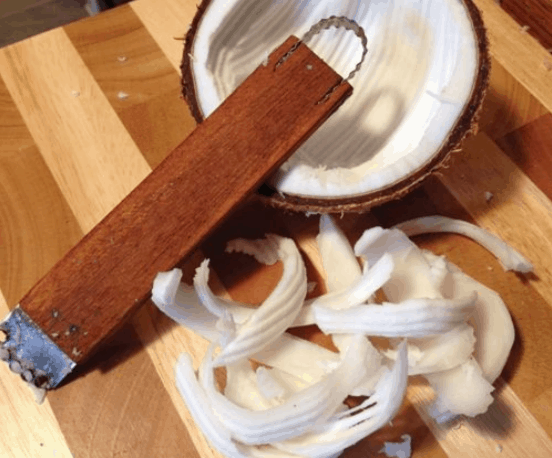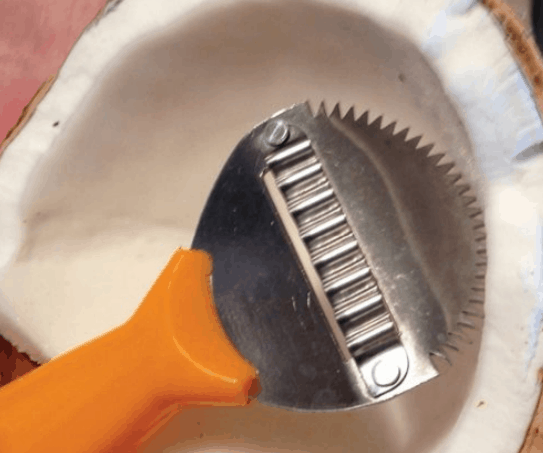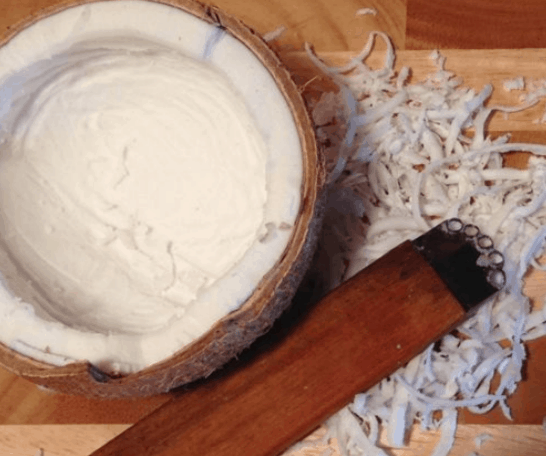Open a coconut, how?
To open a coconut you’ll need good tools for piercing the shell to drain the water, for opening the shell, and for separating the meat from the shell.
While a hammer and screwdriver will work for all of these, they are not the tools of choice. The screwdriver can easily slide or slip across the surface of the coconut shell, even if you are carefully tapping it with the hammer. But if that is all you have, be sure to wrap the coconut in a towel and place it in a large unbreakable bowl first to hold it still while you work. This won’t solve all your problems but it will reduce your risk of injury.
What is a coconut?
Coconut is a round and elongate fruit of white, fibrous and oily meat covered by a thick, brown and hairy shell. Coconuts are surrounded by a fibrous kernel, inside which is a white meat called copra. When the fruit is still tender it yields a milky fluid that is commonly used as basic food in some zones.
The name coconut is derived from the 16th-century Portuguese and Spanish word coco, meaning ‘head’ or ‘skull’ after the three indentations on the coconut shell that resemble facial features.
Following these directions described for other tools will help, but you will often break the shell into shards and pieces rather than breaking it cleanly in half.
For best results, use a simple cork screw, awl or ice pick to remove the water. Then switch to a strong heavy cleaver to open the coconut. Steps to draining the water, opening the coconut and removing the fresh coconut meat from the shell:
1. Open the top of the coconut to remove the coconut water
If using an awl or ice pick, you may wish to start by placing the coconut in a large metal or plastic bowl with a generous lining of kitchen towels to hold it in place and keep it from moving around. It makes the whole job easier.
Wrap the coconut with the towels so the three eyes are facing upwards where you can see them. Use a corkscrew, an awl or an ice pick to puncture the softer eye of the three ‘eyes’ at the top of the shell. You can use your fingernail to determine the soft eye, or look for the ridge lines which shape what look like eyebrows above the two harder eyes.

The soft eye will be positioned like a mouth in relation to the two hard eyes. A corkscrew is the simplest and easiest way to open the eyes. Especially a simple straight one with a good sharp point. Just twist it into the eye until you break through the shell, then back it out and repeat again if necessary.
You may need to wiggle it around a little to widen the hole. If you are using an awl or ice pick, you can tap the base of the handle with a small hammer or rubber mallet, forcing the tip through the eye of the coconut. Then wiggle it about until it creates a hole and you can easily slide your tool back out of the hole. Now you will choose one of the other two eyes to open for an air hole so the water can drain out easily.
Repeat the same process as before, but be careful, because this eye will not be soft and easy to open like the first. You do not need as big a hole either, though. Just enough to let the air in so the liquid can drain out the larger hole you just made.
When the two holes are open, place the coconut with the two eyes facing downward over a glass to catch the coconut water as it drains out.
Drink it or cover it and set it in the fridge to stay cool unless you are going to use it right away in your recipe. Coconut water is most delicious and vital as soon as it comes out of the coconut. You can seal it in a jar or cover the glass with plastic wrap and keep it for up to a week, but it really tastes and is best within the first 24 hours.
2. Open a coconut by splitting it into two pieces
Hold the coconut in your hand so the three eyes are facing you. Think of this as the North Pole of your coconut. Now place your hands around the center of the coconut forming a circle around the midpoint as you hold it this way. Your hands mark the horizontal equator of the coconut.
The horizontal equator is the line you will follow to open it. To do this, tap along the horizontal midpoint of the coconut with the back (NOT the sharp edge) of a heavy cleaver or garden machete. Tap gently and work your way all the way around that equator line and then start around again. Continue to tap your way around in a circle until the shell develops a crack or several cracks along that center line. You now have two choices.

You can either continue to tap until the crack is so severe that one or two stronger thwacks with the back of the cleaver or machete will pop it open, or you can set the cleaver aside and find a good hard surface to smack the almost open coconut against.
We usually do this on a cement step on our back patio. It is not recommended to do this on a countertop. One solid smack with the coconut against a hard edge should split it cleanly into two nice halves.
3. Removing the meat from within the shell
There are lots of tools and different ways to remove the meat from the shell. If you want to use the fresh meat in ribbons, shredded meat or chips, use coconut grating or shredding tools to scrape the meat from the inside of the shell.
If you prefer to remove the pieces without shredding or grating, place the two halves of the coconut shell on a baking sheet, meat side up and bake at 350°F for 15 to 20 minutes until the meat shrinks slightly and releases from the shell.

Then allow the pieces to cool before using a spoon or butter knife to separate the shell from the meat and use a vegetable peeler to remove any dark skins from the shell that are still on the meat. If scraping or shredding the fresh meat, try to scrape only the white meat out of the shell. Scraping too deeply will pull up sections of the brown inner skin of the shell which you do not want.
Remove any brown bits you scrape out inadvertently. With practice you’ll learn just the right pressure to use to avoid the shell bits. When preparing a coconut for grating or shredding, try to avoid large broken-off pieces of coconut or coconut and shell because they are more difficult to work with using these tools. It is best to work with the coconut broken into two clean halves and scrape, grate or shred the meat out of each half of the shell.
Coconut Scraping/Grating/Shredding Tools
Any of the coconut graters, shredders and scrapers make the job easier and much more efficient, so if you’re planning on making fresh coconut a regular part of your diet, you may want to consider picking one up. They are rather inexpensive and don’t take up much space unless you get the full bench model.
Throughout Malaysia, the South Pacific islands, India, Ceylon, Thailand and other coconut growing regions a traditional tool used to scrape the meat from inside of a split coconut shell is a low wooden bench with an iron grating tool or scraping hook attached to one end.
Sometimes called a ‘rabbit’, many of these small, low benches were carved to resemble animals and a rabbit was the most common design. Simple to elaborate versions of the coconut grater with bench or stool are still sold around the world. You can also use a hand held model of the coconut grater or scraper.
These come in a variety of shapes and sizes, some with longer handles which provide better leverage. There are a variety of different ‘heads’ for scraping, shredding, grating or creating thin slices of coconut. There are even sets of tools which offer different combinations of heads at each end of the tool.

New coconut graters include countertop models with suction or mounting clamps and a hand turned rotary blade with a handle on the opposite end of the machine.
There are also various mechanical and electrical models which can be fitted onto other kitchen equipment. Many of these look pretty cool, but in reality are rather tricky to use, particularly if they are not mounted with a clamp into place, as they tend to slide around on the countertop.
They are also a lot of machinery for only one job. The hand tools, in their various sizes and forms, have worked well for perhaps centuries and do a perfectly acceptable job, particularly if you are only working with one or at most two coconuts at a time.
Which tool works best for what job?
The choice of tool is determined by how you want to use the coconut meat. Wide ribbons for curries or making coconut jerky chips are made with a wide single ring shaped grater. For shredded coconut for making coconut milk a fine toothed shredder tool is used.

For a thinner ribbon for making long fine strands of decorative coconut for coconut shrimp, desserts or the final topping of a coconut cream pie, the multiple looped ring head is used.

The large loop end on the back of some scraping tools allows the scooping out of wide slices of coconut meat. These can be used to soak for flavoring drinks, stews, curries and other liquids used in a variety of dishes. They can also be used whole in dishes or fresh or dried, flavored with condiments or sauces.
Fresh coconut can be prepared into all manner of excellent dishes and it has a unique and delicious flavor and delicate texture that is quite distinct. In addition, coconut parts have many uses in our lives, especially the refined coconut oil.
Looking for coconut oil recipes?
Originally posted 2020-08-27 19:59:03.

